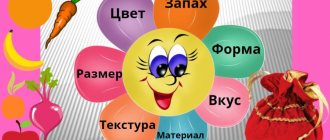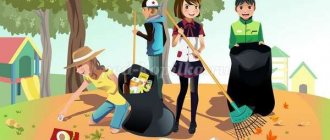Conversation on the topic: “Take care of nature” in the second junior group.
Yulia Garmash
Conversation on the topic: “Take care of nature” in the second junior group.
Conversation : “What is nature ?”
Goal: to let children understand that nature is our common home .
Objectives: To improve children’s skills to distinguish between nature and non-nature , to name objects of living and inanimate nature . Cultivate a love of nature and the ability to empathize.
nature illustrations : animals, plants, etc.
PROGRESS.
1. Reading the poem by V. Orlova “A house under a blue roof”
.
Like a roof over the ground
Blue skies.
And under the blue roof -
Mountains, rivers and forests,
And meadows, and flowers, and of course, me and you.
- What is nature ? (sun, air, water, plants, animals, stones, etc.)
— What cannot be called nature ? (something made by human hands)
— Is there a car in nature ?
- That's right, no. This man made it with his own hands. But what does a person ride in nature ? (horse, camel)
— A horse and a camel are nature . But man tamed , made them domesticated from wild ones, and they existed in nature .
— Man often comes up with things that are similar to nature . The helicopter looks like a dragonfly. Submarine - on a whale.
— The entire nature of the Earth can be divided into two huge worlds. The inanimate world and the living world .
— There are pictures on the table, help me separate them. Put living nature nature on the other .
- Living nature is what moves, grows, develops, reproduces, and dies.
2. Game “Living and inanimate nature ”
.
(they call objects of living nature : children move, inanimate ones stand still)
3. Each of us lives in a house with walls, ceilings and floors - this is our ordinary house. But as soon as we leave the threshold of our house, we find ourselves in another house. This house is nature .
— Once upon a time, nature . Man could not build houses, he hunted animals, fished, and collected plants for food. Time passed and the man learned a lot. Build houses (wooden and brick), fly on an airplane and even into space.
- But still, nature . Why?
— Because a person cannot live without nature : without water, sun, plants, animals.
— Do we have nature in the group ?
Considering two houses: a house of nature , an ordinary house, comparing them.
— What makes your house light? (lamp)
— What can be compared to a lamp in nature ?
- But the sun not only shines, but also warms. (it can be compared with home heaters, with a stove, a battery)
— It rains in nature .
— There is a shower in the house.
- In nature there is wind . There is a fan in the house.
— They lay a carpet on the floor in the house. Grass grows on the ground.
— An ordinary house has stone and wooden walls. And in nature there are mountains and trees .
— We have a flame burning on the gas stove. In nature , fire bursts out of a volcano.
— In nature, snow falls and ice accumulates on high mountains.
— And in an ordinary house, a person learned to make snow in the refrigerator.
— Wild animals in nature . Ours is homemade.
“In the same way, there are wild and indoor plants.
4. Didactic game “
Nature or human hands ” (showing pictures)
Our crafts
Summary of a lesson on familiarization with nature in the junior group “Why are plants needed?”
Summary of a lesson on familiarization with nature in the junior group “Why are plants needed?”
Summary of a lesson on familiarization with nature in the junior group “Why are plants needed?”
Lesson in the younger group on learning about nature
Topic: “Why do we need plants?”
Target:
development of ideas about the relationship of plants with the outside world.
Tasks:
help expand children's knowledge about the importance of trees for animals and people, and develop an understanding of the need to protect the forest.
Progress of the lesson:
(the teacher tells and shows a fairy tale using the necessary visual attributes: the characters Masha and the Bear, several illustrations of spruce trees (forest, woodpecker, mouse, squirrel, crossbill)
- Guys, today I will tell you one very unusual story about Masha, who went skiing into the forest. And since she skated very poorly, from the very first hill she crashed into a tree and got a big bump.
- Why are there so many trees in the forest? – she grumbled, rubbing her forehead.
- Why is this? - she heard a voice - There must be a lot of trees in the forest. – Masha looked around and saw a Bear under the fir tree.
— Masha, trees provide many animals with shelter from predators and the wind. It's warmer here than in an open field. Christmas tree my friend. Besides me, many other animals are friends with the Christmas tree.
- Who else? – asked Masha.
- Look, a squirrel is running along the trunk of that tree. She builds her nest on a Christmas tree, although she can live in a hollow. She also has a lump in her paws
“I know,” said Masha. - She takes out the nuts and eats them.
“That’s right,” answered the Bear.
Then a woodpecker sat on a branch of a broken tree.
“And the woodpecker is friends with the Christmas tree!” said the Bear. “He takes out bugs and spiders from the bark of the tree, and can also feast on cones.”
“The Christmas tree gives the woodpecker food, and he helps her get rid of pests!” said Masha. - They help each other.
- Masha, there are still many animals and birds that are friends with the Christmas tree.
- Yes, now I understand it. The Christmas tree is very necessary for the forest, just like other trees and plants! - said Masha, heading home. – And I’ll definitely learn to ski. – She said goodbye.
Educator: Guys, who else do you think the spruce tree is friends with?
(Children's answers).
Man also needs spruce. From it and other trees growing in the forest, you can build a house, cut firewood for heating, and make boards. What else can you make from boards? Look around, what is made of wood here in the group? (Children's answers)
Cardboard and paper are made from trees. The forest takes a very long time to grow. Therefore, you need to take care of books and handle paper carefully. This will help save the forest.
Educator: In addition, the forest purifies the air and provides the oxygen we breathe. Without a forest, animals and birds cannot live, and people cannot live either. The forest is our wealth! It must be preserved and protected.
— Guys, what does it mean to protect the forest and nature? (Children's answers). That's right, it's not doing anything that could harm him.
- Let's look at the illustrations and tell you what not to do. (a ready-made set of pictures on the topic “What you should not do in the forest: do not break branches, do not trample poisonous mushrooms, do not pick flowers, do not make noise, do not touch or look at nests with bird eggs, do not litter, do not destroy anthills and do not catch wild animals").
- Well done guys, now I know for sure that when you go into the forest into nature, you won’t do anything bad.
- Guys, but we don’t go to the forest every day. How can we live in a city without plants and trees? (children's answers).
— In order to breathe clean air and create beauty around them, people improve their homes and streets. They plant trees and shrubs in their yards and streets. And in the spring, they plant a huge number of colorful flowers, which not only make us happy, but also purify our air, just like the trees.
- Today we will also try to make sure that our air is cleaned. And we were in a great mood all summer. Today we will plant flower seeds on your windowsill, which we will take care of all spring. And when the sun warms up the ground well outside, you and I will plant them in a flowerbed on our site!
(On the table is a box of seedlings, marigold seeds, and soil for planting. Children and the teacher plant plants).
— Today we learned how important trees and other plants are for us! Let's remember. (Children's answers)
- What did you like most of what we did today (Children’s answers)
Long-term environmental planning in the second junior group
Long-term planning for environmental education of preschool children under the “Childhood” program
I bring to your attention an approximate long-term planning for environmental education.
I hope the material will be useful to my colleagues, especially if their institution works with the “Childhood” program. You can, of course, choose classes at your own discretion, but this planning takes into account all the tasks set by the “Childhood” program. II junior group Tasks for the first quarter 1. Teach children to identify and name the nature of the weather: warm, cold, raining, wind blowing; 2. Know the typical signs of autumn: cloudy, rainy, leaves turn yellow, red, fall to the ground; 3. To provide basic knowledge in establishing the simplest patterns, to pay attention to the causes, connections, relationships of phenomena of living and inanimate nature; Encourage interest in experimentation. 4. Introduce the diversity of flora and fauna; 5. Learn to distinguish and recognize 2-3 domestic and wild animals and plants by external signs; 6. Show interest in the work of adults in caring for animals and plants. expand and consolidate the ability to recognize and name indoor plants, compare them according to characteristics that are significant for care (the nature of the surface of the leaves, their number, location). September A world of amazing discoveries. Lesson I: “Water-water” Purpose: To clarify children’s understanding that water is very important for all living beings, without it plants, animals, people cannot live (people need water for food, drinking, for washing the body and everything items that are in the room); To develop in children knowledge about the importance of water in human life: water is the source of life; water is necessary to maintain and ensure human life; Instill respect for water; Lesson II
: Experimental lesson
“Weather phenomena. Rain" Purpose: To systematize children's knowledge about changes in inanimate nature and weather phenomena. To form in younger preschoolers an idea of the world around them; interest in experimentation. October We need all kinds of plants! All kinds of plants are important! Lesson I:
on getting acquainted with nature
“Auntie the gardener” Purpose: To clarify the idea of the appearance of vegetables and fruits. Form a generalization (vegetables grow in a vegetable garden, a field, fruits in a garden). Learn to distinguish by appearance and taste and name vegetables (cucumber, tomato, carrot, turnip). Expand your understanding of growing vegetables. Lesson II: Introduction to indoor plants Purpose:
To provide basic knowledge about the structure of plants, to teach to recognize and name the parts of a plant - they have roots, stems, leaves, flowers.
They are alive - growing, multiplying. To form children's ideas that plants can bloom, have smells, they turn yellow, wither, and dry. November Animals and birds are our friends! Lesson I:
Didactic game
“Let’s go flying!” Goal: To teach children to recognize and name a sparrow, dove, cuckoo, and to see some features of their appearance. Introduce some behavioral features: fly, jump, peck; With the onset of autumn, cuckoos and swallows fly away to warmer climes. Lesson II: “Pets” Purpose: To consolidate and expand children’s knowledge about domestic animals and their cubs. Teach children to distinguish an adult animal from a baby. Cultivate a caring attitude towards animals. Objectives for the second quarter 1. Expand children's understanding of inanimate nature phenomena in winter (frost, cold winds blow, snow falls, lakes and rivers are frozen, snowstorms are blowing, the day is shorter than the night. The sky is gray, there are clouds and clouds on it). 2. Learn to determine the state of the earth and water; establish connections between living and inanimate nature (weather - the state of water, snow, time of year - the state of plants, human clothing). 3. Learn to compare and distinguish between coniferous and deciduous trees. 4. Clarify children’s ideas about the lifestyle of wild animals in winter, establishing simple connections between winter conditions and the behavior of animals. December Hello, Zimushka-winter! Lesson I: “How the kitten was surprised by winter” Purpose: To clarify ideas about the signs of winter (it’s cold, it’s snowing, you can play with the snow). Through a fairy tale, introduce children to where snow comes from and why it comes. Give children a joyful experience of a winter walk. Lesson II
:
“Christmas tree - green needle.” Goal: To teach children to recognize and distinguish a Christmas tree (spruce branches grow along the entire trunk from the top to the ground, lowered down, the needles are short, the cones are oblong). Clarify that spruce is a coniferous tree, evergreen, very beautiful, they must be protected. January We and they are alive! Lesson I: “Who lives in the forest?” Goal: To introduce animals living in forests. Learn to distinguish and recognize a fox, a hare, a wolf in a picture; note characteristic signs. Introduce the lifestyle of animals and the main methods of nutrition. Develop an interest in animals. Lesson II: “Planting onions” Purpose: To clarify ideas about bulbs (they are round, yellow, have tops and roots); develop planting skills: place in the hole, press firmly, sprinkle with soil and water; arouse interest in growing plants. February “Go away, shaggy frost!” Lesson I: “Winter's Tale” Purpose: To consolidate children's knowledge about winter, as a season and seasonal changes in the animal world. Lesson II: “A bunny visiting children of the younger group” Purpose: to introduce children to the properties of materials: stone and cotton wool. - teach children to distinguish and name the qualities of objects “hard” and “soft”; Tasks for the third quarter 1. Accumulation and generalization of primary ideas about the most striking phenomena occurring in nature in spring: plant growth, their flowering; intensive growth of animals, the appearance of their young. Mastering the dependence of the growth of plants, animals, insects on environmental conditions. 2. Distinguishing and naming plants, birds (rook, crow, swallow), insects (ladybug, butterfly, bumblebee, beetle;). 3. Support children's curiosity and develop children's interest in joint and independent learning with adults (observe, examine, experiment with a variety of materials), March Spring! How wonderful is your awakening! Lesson I: “Spring. What colors does spring have?” Purpose: to give children an idea of spring changes in nature; learn to compare seasons, note characteristic features; develop interest in natural phenomena; develop color perception: autumn – yellow, winter – white, spring – green; cultivate a caring attitude towards the awakening of nature, towards its individual phenomena. Lesson II: “Planting pea seeds” Purpose: To develop children’s ability to plant seeds: make a hole with a stick, take a seed and lower it into the hole, take a stick and sprinkle soil onto the seed from the edges of the hole. To cultivate a desire to grow a plant with edible fruits from seeds. April No winter - spring has come! Lesson I: “Insects” Purpose: To introduce children to insects: ladybug, butterfly, bumblebee, beetle; To consolidate knowledge of the parts of insects: head, antennae, wings, body, legs; Develop the ability to guess riddles by description; Strengthen the ability to count and compare the number of parts of insects; Foster a caring attitude towards insects; Lesson II: “Birch tree in spring” Purpose: To train children in the ability to find familiar trees by one or two characteristic features; Know the characteristics of spruce and birch - clarify ideas about the structure (trunk, root, top, branches, leaves, needles on branches and cones); Introduce the structure of a birch trunk. Show the relationship of the tree with the environment (water, soil, animals, sun - light, heat); May Spring is coming everywhere! Lesson I: “Observing a dandelion” Purpose: To develop interest in cognitive research activities on the topic “Flowers.” To form ideas about the dandelion as a flower and its distinctive features. Lesson II: “Properties of sand” Purpose: to introduce children to the properties of sand; systematically and consistently examine objects, the ability to notice individual details of the overall picture. To develop children's observation skills, the ability to compare, establish basic cause-and-effect relationships and draw simple conclusions. Introduce safety rules when conducting experiments.
We recommend watching:
Calendar - thematic planning in the second junior group for December Calendar - thematic planning in the second junior group for November Long-term plan for working with parents in the second junior group Educational program of additional education of artistic and aesthetic orientation for
Similar articles:
Planning classes on FEMP in the second junior group according to the Federal State Educational Standard for a year


